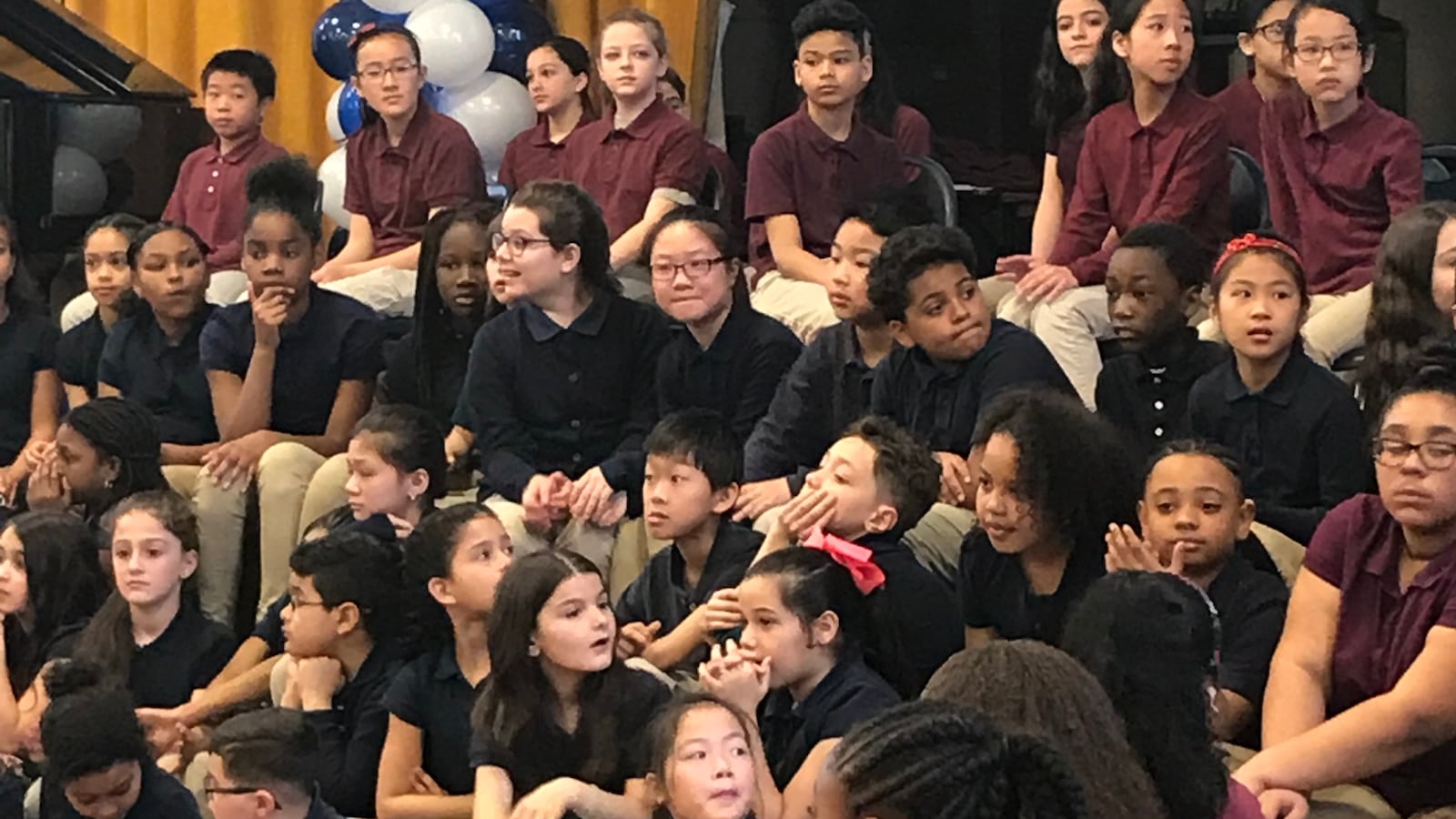This article was originally published in The Notebook. In August 2020, The Notebook became Chalkbeat Philadelphia.
Mayfair Elementary School, with nearly 1,800 students, is by far the largest elementary school in Pennsylvania.
As other schools around the city cope with shrinking populations, Mayfair just added two colorful new additions, which house classrooms and a new cafeteria with a full kitchen, to its original 1949 building in the Mayfair section of Northeast Philadelphia. The K-8 school’s enrollment has exploded from just over 1,000 only six years ago.
Mayfair, a complex of buildings sprawled across a city block and surrounded by neat rowhomes, now has a new distinction. It is one of only three schools in the state, and the only public school, that is certified to offer the International Baccalaureate curriculum in both primary and middle grades.
Last week, Mayor Kenney, Superintendent William Hite, and City Councilman Bobby Henon visited the school to celebrate the achievement, which took years of preparation and required the buy-in of its 130-member staff.
‘When I came in 2012, I noticed that kids were asking to put what they were learning in context,” said principal Guy Lowery. “They were saying, ‘We learn all these great things. Now what?’”
Plus, his students’ families come from all over the world – more than 60 countries, which makes it one of the most diverse in the state. Almost a quarter of Mayfair’s students are English learners; among the languages spoken are Mandarin Chinese, Spanish, Portuguese, Arabic, and Albanian.
So Lowery investigated IB, with its inquiry focus and commitment to creating world citizens. Overseen by the International Baccalaureate organization based in Geneva, Switzerland, the curriculum stresses critical thinking as well as personal qualities of kindness and motivation, with the aim of creating lifelong learners. Unlike Advanced Placement, which offers a series of college-level classes from which students can pick and choose, the IB program is a coordinated course of study. An IB diploma is a benefit on college applications.
Requirements for a school to become fully certified include a feasibility study, proof of the school’s commitment and ability to sustain the program over time, and an analysis of how it will benefit the community.
“IB certification is not easy to come by,” said Hite. The curriculum “encourages students to think critically and challenge assumptions and to do research in their community. It invites all students to consider issues in a global context.”
Lowery said that although the IB curriculum focuses on the state’s and the District’s content requirements and standards, “now the students learn how to apply the knowledge and what to do after that.”
This was obvious when 8th grader Haohui Zhang confidently explained to Kenney and Hite how his group’s homemade windmill, made of plastic and cardboard, could be adjusted to produce more energy. (Changing the shape of the blades is one approach.)
“Inquiry-based learning allows them to start from scratch and build toward a goal,” said teacher Jade Hayes. “I’m not guiding them. I’m letting them figure it out on their own.”
For Hayes, an environmental scientist who took up teaching two years ago as a second career, this makes perfect sense.
“Everyone learns at a different pace and in a different way,” she said. “This allows them to be more creative.”
It also makes sense to Zhang, whose family recently moved to the Northeast from Missouri. This is his first year at Mayfair, and he will attend the aerospace magnet program at Northeast High starting in September.
“In my old school, we didn’t do this,” said Zhang. “Here we have more opportunity to do labs and designs.”
Veteran teachers were also happy to jump on board, even though doing IB required time-intensive retraining and an enhanced focus on collaboration.
“I love it,” said Gia Fioravanti, a literacy learning support teacher for the middle grades who was one of several Mayfair teachers who went to Colorado for the training. She noted that the IB program, besides having the benefits of hands-on learning, “helps the kids have a sense of belonging in how diverse we are. We welcome talking about all cultures.”
In doing projects, she said, instead of thinking about students’ learning disabilities, “we try to bring in every kid and enhance their abilities, what they know, and what they bring to the table.”
The school used some of these techniques before, she said, but “the connection is on a large scale.” Converting the school to IB with such a large staff “took a lot of hard work.”
Lowery said that due to the enrollment surge, he had to recruit dozens of new teachers, such as Hayes, and vetted them for their commitment to the program.
“We wanted to make sure they understood what IB was,” he said. “Jade ate it up.”
Unlike some schools, which limit IB to only certain students, Mayfair makes it available to all. That is a big inducement in what is clearly a hot Philadelphia neighborhood. Other schools in the city that offer IB – Woodrow Wilson Middle School, and Bodine, Central, Girls’, Northeast, and Washington High Schools – do so as a program for selected students. Hill-Freedman Middle and High School in Mount Airy is the only other city school that uses IB as the default curriculum.
At an assembly before the dignitaries took a tour, Mayfair student choirs sang and roused the audience with their spirited bucket drumming, which has its roots in street performing.
“The future of the city depends on having quality schools like this in every neighborhood,” Kenney told the crowd. “This is a great example of what our schools can aspire to.
“Look around the room. Look at how beautiful and diverse you are. This is what America is and what America should be. … My own folks came from Ireland. … You and your families are doing the same thing. Don’t let anybody tell you you don’t belong.”


